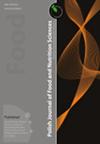干燥、真空和改性气氛老化对Roe Deer肉理化性能的影响
IF 2.3
4区 农林科学
Q3 FOOD SCIENCE & TECHNOLOGY
引用次数: 1
摘要
世界各地的消费者都在选择可持续和未加工的食品。Roe鹿肉,由于其天然来源,是有机健康肉类的来源。选择合适的储存条件和时间对肉的功能和营养价值的恶化起着重要作用。关于采用不同方法储存和包装的鱼子的氧化过程的知识是有限的。因此,本研究的主要目的是研究储存方法对马鹿胸腰最长肌(LTL)、股二头肌(BF)和股外侧肌(VL)理化性质的影响。将肌肉干燥(dry-AGED)、真空包装(VAC)或在改良气氛(MAP)下包装21天。根据蛋白质和脂质的化学成分、工艺特性、pH值、水活性、颜色以及氧化过程来评估鱼子的质量。Roe鹿肉蛋白质含量高(216.5–228.6 g/kg),脂肪含量低(17.1–25.8 g/kg)。DRY-AGED和VAC都有助于改善肉在储存过程中的嫩度,而MAP肌肉的Warner–Bratzler剪切力增加。MAP储存过程中的高氧条件强烈地诱导了氧化过程;硫代巴比妥酸反应物质(TBARS)水平在第21天平均增加1263%,蛋白质羰基含量平均增加155%。推荐采用真空包装和干燥老化的方法储存鱼子。高氧气的环境对这种野味的质量产生了负面影响。它具有蛋白质和脂质氧化增加的风险,这可能会促进潜在有害化合物的形成本文章由计算机程序翻译,如有差异,请以英文原文为准。
Effect of Dry, Vacuum, and Modified Atmosphere Ageing on Physicochemical Properties of Roe Deer Meat
Consumers around the world are choosing sustainable and unprocessed foods. Roe deer meat, due to the natural origin, is a source of organic and healthy meat. The selection of suitable storage conditions and times plays an important role in a deterioration of the meat’s functional and nutritional values. The knowledge about oxidation processes in roe deer meat stored and packed deploying different methods is limited. The main aim of this study was therefore to investigate the effect of storage method on the physicochemical properties of musculus longissimus thoracis et lumborum (LTL), musculus biceps femoris (BF), and musculus vastus lateralis (VL) of roe deer. The muscles were stored either dry (DRY-AGED), vacuum-packed (VAC), or packed under modified atmosphere (MAP) for 21 days. The quality of roe deer meat was assessed based on chemical composition, technological properties, pH values, water activity, colour, and oxidation processes of proteins and lipids. Roe deer meat had high protein (216.5–228.6 g/kg) and low fat content (17.1–25.8 g/kg). Both DRY-AGED and VAC contributed to improving meat tenderness during storage, while the Warner–Bratzler shear force of the MAP muscles increased. The high-oxygen conditions during MAP storage strongly induced the oxidation processes; an average increase of 1,263% for thiobarbituric acid reactive substance (TBARS) level and 155% for protein carbonyl content on day 21. Vacuum packaging and dry-ageing are recommended methods for storing roe deer meat. The high oxygen atmosphere negatively affected the quality of this game species. It carries the risk of increased oxidation of proteins and lipids which may promote the formation of potentially detrimental compounds
求助全文
通过发布文献求助,成功后即可免费获取论文全文。
去求助
来源期刊

Polish Journal of Food and Nutrition Sciences
FOOD SCIENCE & TECHNOLOGY-
CiteScore
4.30
自引率
12.50%
发文量
25
审稿时长
20 weeks
期刊介绍:
The Polish Journal of Food and Nutrition Sciences publishes original, basic and applied papers, reviews and short communications on fundamental and applied food research in the following Sections:
-Food Technology:
Innovative technology of food development including biotechnological and microbiological aspects
Effects of processing on food composition and nutritional value
-Food Chemistry:
Bioactive constituents of foods
Chemistry relating to major and minor components of food
Analytical methods
-Food Quality and Functionality:
Sensory methodologies
Functional properties of food
Food physics
Quality, storage and safety of food
-Nutritional Research Section:
Nutritional studies relating to major and minor components of food (excluding works related to questionnaire
surveys)
-“News” section:
Announcements of congresses
Miscellanea
 求助内容:
求助内容: 应助结果提醒方式:
应助结果提醒方式:


